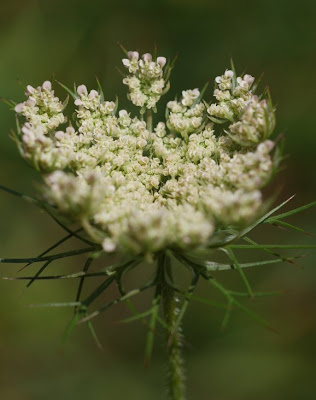
Queen Anne's Lace bears its tiny flowers in large, showy umbels, but you can better appreciate the bracts on the axillary shoots with their punier inflorescenses. I fell in love with plant anatomy in my first year of college, perhaps because of the magical yet precise language. Whatever you call them, I think the modified leaves that enwrap the flowerheads are quite handsome.
As usual, the links:
- Connecticut Botanical Society's Queen Anne's Lace page has this ethnobotanical note:
Queen Anne's lace was introduced from Europe as a medicinal plant. The vegetable carrot was bred from this plant.
- USDA Plants Database entry for Daucus carota L., Queen Anne's lace
- Queen Anne's Lace description from Cannon Valley Nurseries, Minnesota's premiere bulk wildflower seed distributor and search engine:
Also known as Queen Anne's Lace. The seeds are a beneficial antiseptic diuretic useful in the treatment of cystitis and prostatitis. Also, the seeds are used for the prevention and washing out of gravel and urinary stones. As a diuretic, it helps with dropsy and the elimination of uric acid from the body (thus, used for gout). The seeds, which are high in volatile oil, are soothing to the digestive system, useful for colic and flatulence. Some herbalists employ the seeds as an implantation preventer. The root is very high in Vitamin A and minerals. The juice is reputed to have anti-cancer activity. The root helps to expel worms and is an effective antacid for heartburn and gastritis. A poultice of the root is excellent for first aid, especially for itchy skin. CAUTION: Queen Anne's Lace has several poisonous look alikes. Do NOT use this herb (seeds) with pregnancy.

No comments:
Post a Comment